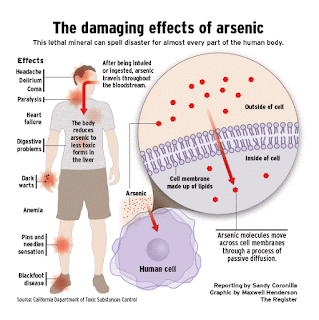EcoWaste Coalition Pushes Ban on Use of Arsenic for Wood Treatment and Preservation
http://www.ocregister.com/articles/kim-515837-mine-toxic.html
The EcoWaste Coalition urged the Department of Environment and Natural Resources – Environmental Management Bureau (DENR-EMB) to strengthen the proposed regulation on toxic inorganic arsenic, a known carcinogen, by removing exemption on its use in pesticides for the treatment of wood.
As the lead agency in charge of drawing up regulatory controls for substances in the Philippine Priority Chemicals List, the non-profit toxics watch group lauded the DENR-EMB for embarking on such a policy initiative that will regulate, phase out or ban arsenic and its compounds as these chemicals pose serious risks to public health and the environment.
“We support the issuance of the said CCO and specifically support the ban on arsenic and arsenic compounds in the manufacturing of fertilizers, pesticides, wood treatment and preservation products, commercial pigments and paints, toys, school supplies and cosmetics,” stated Eileen B. Sison, President, EcoWaste Coalition, in a letter delivered to the DENR last Monday.
At the same time, the group sought a more stringent short-term exposure limit to protect workers’ health and the removal of the exemption on the use of arsenic for pesticides used in the treatment of wood.
The group also asked for a more rational phase-out timelines for arsenic-containing wood treatment and preservation products that will prioritize the removal from the market of those products posing the highest exposure risk to children, women and other vulnerable sectors.
Information from the Toxicology Data Network indicates that chromated copper arsenate or CCA is used in pressure treated wood to protect it from rotting due to insects and microbial agents. In US, effective December 31, 2003, no wood treater or manufacturer may treat wood with CCA for residential uses, with certain exceptions.
As described by the World Health Organization (WHO), “the intake of the acutely toxic inorganic arsenic over a long period of time can lead to chronic arsenic poisoning or arsenicosis.” The WHO has listed arsenic among the “ten chemicals of major public health concern.”
“Effects, which can take years to develop depending on the level of exposure, include skin lesions, peripheral neuropathy, gastrointestinal symptoms, diabetes, renal system effects, cardiovascular disease and cancer,” the WHO said.
As long-term actions are required to reduce exposure to arsenic, the EcoWaste Coalition recommended removing exemption in the draft CCO permitting the use of arsenic in pesticides for wood treatment.
The group cited the “Arsenic Treated Wood Ordinance” in San Francisco, USA to justify the removal of such exemption, which says that “preservative-treated wood containing arsenic poses potential human health and environmental risks through the release of arsenic during manufacture, installation, and disposal of wood.”
According to the US National Center for Healthy Housing, “arsenic can leach to the surface of the treated wood, becoming accessible for absorption through exposed hands and skin touching the wood surface and, especially in the case of children, ingestion through normal hand-to-mouth behavior.”
The EcoWaste Coalition also cited that under the European Union’s Registration, Evaluation, Authorisation and Restriction of Chemicals (REACH), “arsenic compounds shall not be used in the preservation of wood. Furthermore, wood so treated shall not be placed on the market.”
With respect to the phase-out timelines, the EcoWaste Coalition suggested that a survey be conducted in order to prioritize the phase-out of wood and treatment preservation products that present the highest exposure risk to children, women, workers and other potentially disproportionately exposed populations.
“The government through the CCO can then make appropriate phase-out timelines and encourage the market for safer alternatives,” it said.
The current draft of the CCO would allow the use for three years of arsenic-containing wood treatment and preservation products for architectural, decorative and household uses and six years for industrial uses.
-end-
Reference:
http://emb.gov.ph/wp-content/u ploads/2016/09/CCO-for-Arsenic -Draft-4-edited.pdf
http://www.who.int/ipcs/assess ment/public_health/chemicals_p hc/en/
http://www.nchh.org/What-We-Do /Health-Hazards--Prevention-- and-Solutions/ArsenicTreated-W ood.aspx
http://www.who.int/ipcs/assess ment/public_health/chemicals_p hc/en/
http://www.nchh.org/What-We-Do /Health-Hazards--Prevention-- and-Solutions/ArsenicTreated-W ood.aspx






Comments